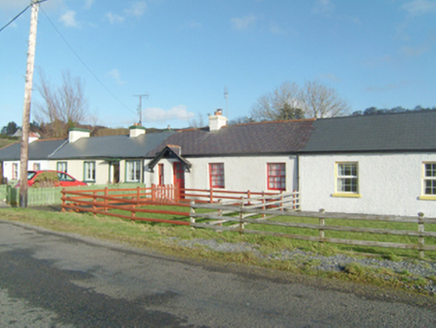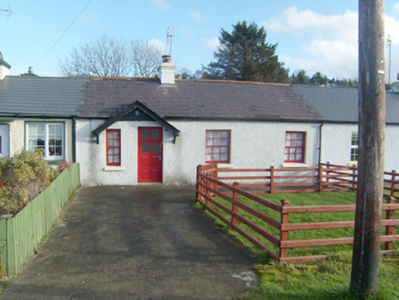Survey Data
Reg No
40837020
Rating
Regional
Categories of Special Interest
Architectural, Social
Original Use
House
In Use As
House
Date
1900 - 1920
Coordinates
182289, 393544
Date Recorded
17/11/2010
Date Updated
--/--/--
Description
Attached terraced four-bay single-storey former local authority house, built c. 1910, having canopy porch over main doorway. One of a terrace of six buildings. Now in use as a private dwelling with single-storey extension to the rear (east). Pitched natural purple slate roof with terracotta ridge tiles, replacement rainwater goods, and with smooth rendered chimneystack (offset to the north side of centre) having cornice coping and clay ware pots over. Canopy porch over entrance door supported on timber brackets having pitched purple slate roof, terracotta ridge tiles, and with battened timber panelling to gable apex. Roughcast rendered walls. Square-headed window openings with painted stone sills, and with six-over-six and four-over-four (flanking doorway to the north) pane timber sliding sash windows. Square-headed door opening with replacement timber door. Set back from road in own grounds in the rural countryside to the south of Glenties. Tarmacadam driveway and lawned area to front (west) surrounded by modern timber fencing.
Appraisal
This simple but appealing house retains its original form and character. Its integrity is enhanced by the retention of its original window fittings and the natural slate roof. The form of this building and that of its neighbours suggests that it was originally built as social housing by the relevant local authority or, perhaps, by the Congested Districts Board (founded 1891). It dates to a period when a great many houses of this type were built in Ireland following the passing of the various Land and Labourers' Acts (c. 1883-1921) by the British Parliament in the late-nineteenth and early-twentieth centuries, and they are a ubiquitous feature of the many Irish towns and villages, and indeed the Irish rural countryside. The vast majority of these buildings are now heavily altered, as is the case in a group of six buildings to the south of Glenties, making this building a rare surviving intact example of its type. This simple house is well-built to a conscious architectural design, which could be viewed as an 'improved' interpretation of the vernacular housing of the time. This modest structure is an interesting part of the social history and built heritage of the Glenties area, and is an appealing feature in the local landscape.







